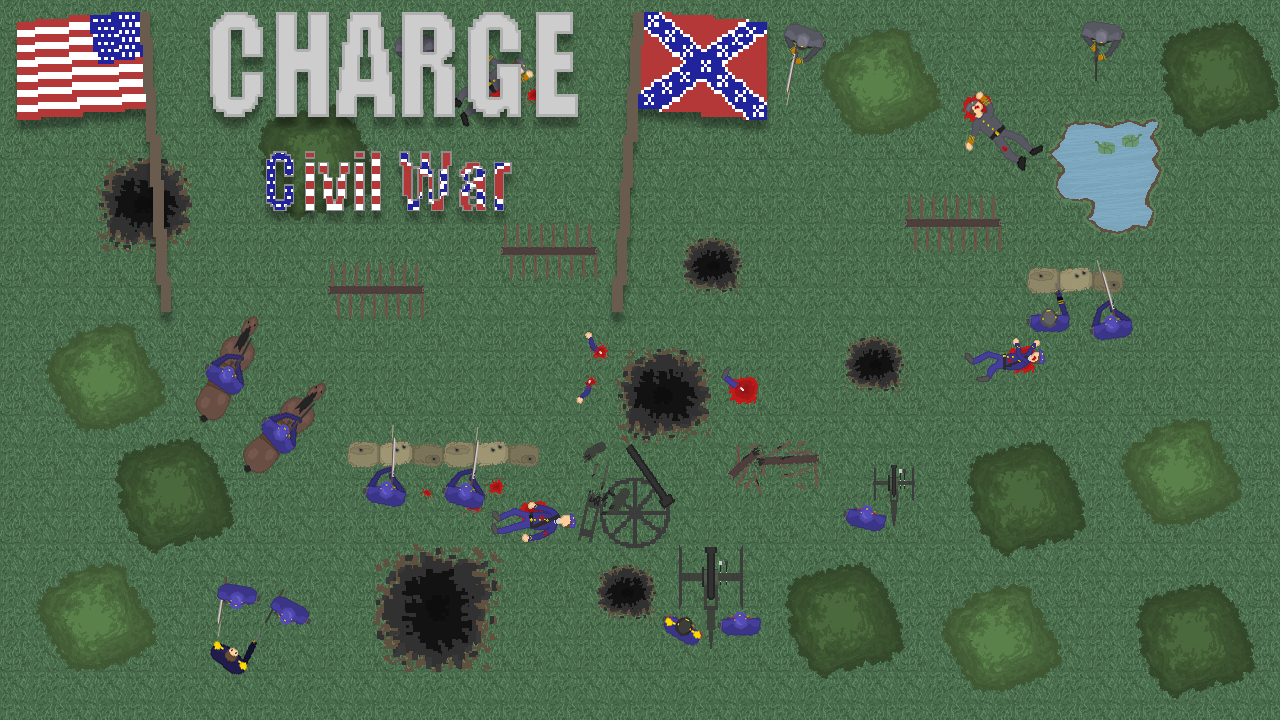2 Results Of The Civil War
Posted By admin On 02/08/22The English Civil War (1642–1651) was a series of civil wars and political machinations between Parliamentarians ('Roundheads') and Royalists ('Cavaliers'), mainly over the manner of England's governance and issues of religious freedom. It was part of the wider Wars of the Three Kingdoms.The first (1642–1646) and second (1648–1649) wars pitted the supporters of King Charles I against the. 'On the verge' of civil war. Those sentiments might help explain the conclusion of a new survey that finds a majority of U.S. Adults believe the country is 'on the verge' of a second civil war.
- Year Of The Civil War
- 2 Results Of The Civil War In Ireland
- 2 Effects Of The Civil War That Still Apply Today
- 2 Results Of The Civil War
It is estimated that from 752,000 to 851,000 soldiers died during the American Civil War. This figure represents approximately 2 percent of the American population in 1860. The Battle of Gettysburg, one of the bloodiest engagements during the Civil War, resulted in. The American Civil War was one of the most devastating wars in America’s history. The war did not only divide the country, but it also divided families. There were a lot of things that led to the Civil War but, I believe the primary source of the North/South conflict that led to the Civil War was the issue over Free states vs. The American Civil War was fought from April 12, 1861 to May 9, 1865 between the Union forces and the 11 Southern states that seceded from the Union and formed the Confederate States of America. Ultimately won by the Union forces, it remains the deadliest battle for the country with estimated deaths between 600,000 and 800,000.
It was quite the thing, a major rift in the country, very intense feelings, heavy losses on both sides, etc. Such deep-seated events take time to dissipate and often pain, grief, hatred, and so on are passed on from generation to generation on either a conscious or subconscious level.
Since only some 4 generation are in between then and now, that's not much at all.
So does it have long-term effects on people, society etc? Is there really a general sense of union among the south & north? Or is this only skin-deep and if something triggers it, it surfaces strongly again?
I could probably Google, but what better way to learn about this than from Americans themselves that likely have civil war stories & history in their family line.
Year Of The Civil War

Our editors will review what you’ve submitted and determine whether to revise the article.
 Join Britannica's Publishing Partner Program
Join Britannica's Publishing Partner Program and our community of experts to gain a global audience for your work!
and our community of experts to gain a global audience for your work! English Civil Wars, also called Great Rebellion, (1642–51), fighting that took place in the British Isles between supporters of the monarchy of Charles I (and his son and successor, Charles II) and opposing groups in each of Charles’s kingdoms, including Parliamentarians in England, Covenanters in Scotland, and Confederates in Ireland. The English Civil Wars are traditionally considered to have begun in England in August 1642, when Charles I raised an army against the wishes of Parliament, ostensibly to deal with a rebellion in Ireland. But the period of conflict actually began earlier in Scotland, with the Bishops’ Wars of 1639–40, and in Ireland, with the Ulster rebellion of 1641. Throughout the 1640s, war between king and Parliament ravaged England, but it also struck all of the kingdoms held by the house of Stuart—and, in addition to war between the various British and Irish dominions, there was civil war within each of the Stuart states. For this reason the English Civil Wars might more properly be called the British Civil Wars or the Wars of the Three Kingdoms. The wars finally ended in 1651 with the flight of Charles II to France and, with him, the hopes of the British monarchy.
Personal Rule and the seeds of rebellion (1629–40)

Compared with the chaos unleashed by the Thirty Years’ War (1618–48) on the European continent, the British Isles under Charles I enjoyed relative peace and economic prosperity during the 1630s. However, by the later 1630s, Charles’s regime had become unpopular across a broad front throughout his kingdoms. During the period of his so-called Personal Rule (1629–40), known by his enemies as the “Eleven Year Tyranny” because he had dissolved Parliament and ruled by decree, Charles had resorted to dubious fiscal expedients, most notably “ship money,” an annual levy for the reform of the navy that in 1635 was extended from English ports to inland towns. This inclusion of inland towns was construed as a new tax without parliamentary authorization. When combined with ecclesiastical reforms undertaken by Charles’s close adviser William Laud, the archbishop of Canterbury, and with the conspicuous role assumed in these reforms by Henrietta Maria, Charles’s Catholic queen, and her courtiers, many in England became alarmed. Nevertheless, despite grumblings, there is little doubt that had Charles managed to rule his other dominions as he controlled England, his peaceful reign might have been extended indefinitely. Scotland and Ireland proved his undoing.
In 1633 Thomas Wentworth became lord deputy of Ireland and set out to govern that country without regard for any interest but that of the crown. His thorough policies aimed to make Ireland financially self-sufficient; to enforce religious conformity with the Church of England as defined by Laud, Wentworth’s close friend and ally; to “civilize” the Irish; and to extend royal control throughout Ireland by establishing British plantations and challenging Irish titles to land. Wentworth’s actions alienated both the Protestant and the Catholic ruling elites in Ireland. In much the same way, Charles’s willingness to tamper with Scottish land titles unnerved landowners there. However, it was Charles’s attempt in 1637 to introduce a modified version of the English Book of Common Prayer that provoked a wave of riots in Scotland, beginning at the Church of St. Giles in Edinburgh. A National Covenant calling for immediate withdrawal of the prayer book was speedily drawn up on February 28, 1638. Despite its moderate tone and conservative format, the National Covenant was a radical manifesto against the Personal Rule of Charles I that justified a revolt against the interfering sovereign.
The Bishops’ Wars and the return of Parliament (1640–42)
The turn of events in Scotland horrified Charles, who determined to bring the rebellious Scots to heel. However, the Covenanters, as the Scottish rebels became known, quickly overwhelmed the poorly trained English army, forcing the king to sign a peace treaty at Berwick (June 18, 1639). Though the Covenanters had won the first Bishops’ War, Charles refused to concede victory and called an English parliament, seeing it as the only way to raise money quickly. Parliament assembled in April 1640, but it lasted only three weeks (and hence became known as the Short Parliament). The House of Commons was willing to vote the huge sums that the king needed to finance his war against the Scots, but not until their grievances—some dating back more than a decade—had been redressed. Furious, Charles precipitately dissolved the Short Parliament. As a result, it was an untrained, ill-armed, and poorly paid force that trailed north to fight the Scots in the second Bishops’ War. On August 20, 1640, the Covenanters invaded England for the second time, and in a spectacular military campaign they took Newcastle following the Battle of Newburn (August 28). Demoralized and humiliated, the king had no alternative but to negotiate and, at the insistence of the Scots, to recall parliament.
2 Results Of The Civil War In Ireland
A new parliament (the Long Parliament), which no one dreamed would sit for the next 20 years, assembled at Westminster on November 3, 1640, and immediately called for the impeachment of Wentworth, who by now was the earl of Strafford. The lengthy trial at Westminster, ending with Strafford’s execution on May 12, 1641, was orchestrated by Protestants and Catholics from Ireland, by Scottish Covenanters, and by the king’s English opponents, especially the leader of Commons, John Pym—effectively highlighting the importance of the connections between all the Stuart kingdoms at this critical junction.
To some extent, the removal of Strafford’s draconian hand facilitated the outbreak in October 1641 of the Ulster uprising in Ireland. This rebellion derived, on the one hand, from long-term social, religious, and economic causes (namely tenurial insecurity, economic instability, indebtedness, and a desire to have the Roman Catholic Church restored to its pre-Reformation position) and, on the other hand, from short-term political factors that triggered the outbreak of violence. Inevitably, bloodshed and unnecessary cruelty accompanied the insurrection, which quickly engulfed the island and took the form of a popular rising, pitting Catholic natives against Protestant newcomers. The extent of the “massacre” of Protestants was exaggerated, especially in England where the wildest rumours were readily believed. Perhaps 4,000 settlers lost their lives—a tragedy to be sure, but a far cry from the figure of 154,000 the Irish government suggested had been butchered. Much more common was the plundering and pillaging of Protestant property and the theft of livestock. These human and material losses were replicated on the Catholic side as the Protestants retaliated.
The Irish insurrection immediately precipitated a political crisis in England, as Charles and his Westminster Parliament argued over which of them should control the army to be raised to quell the Irish insurgents. Had Charles accepted the list of grievances presented to him by Parliament in the Grand Remonstrance of December 1641 and somehow reconciled their differences, the revolt in Ireland almost certainly would have been quashed with relative ease. Instead, Charles mobilized for war on his own, raising his standard at Nottingham in August 1642. The Wars of the Three Kingdoms had begun in earnest. This also marked the onset of the first English Civil War fought between forces loyal to Charles I and those who served Parliament. After a period of phony war late in 1642, the basic shape of the English Civil War was of Royalist advance in 1643 and then steady Parliamentarian attrition and expansion.
- 1642 - 1651
- location
2 Effects Of The Civil War That Still Apply Today

2 Results Of The Civil War
- key people
- Religion was one of the dividing factors in the war: conservative Protestants and Catholics sided with the King and Puritans sided with Parliament.
- Many of the King's supporters abandoned him after he worked to recruit foreign soldiers to his cause.
- The public was incensed by Charles' invasion of Parliament and armed demand for five of the MPs in 1642.